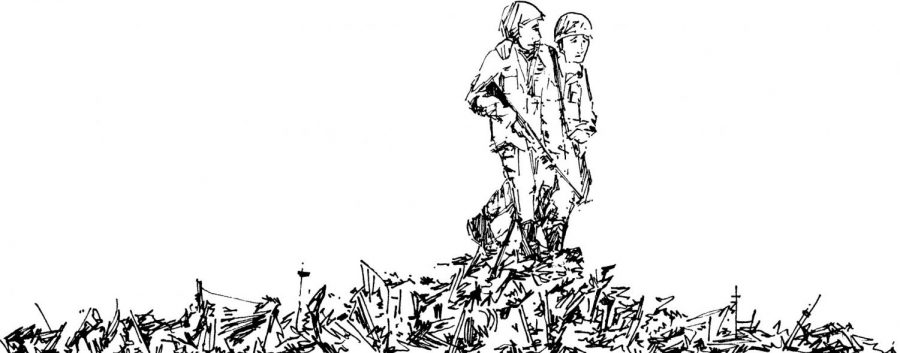
It is a bit of a letdown that our quaint little town can’t revel in the wonders of art-house cinema. I read somewhere recently that eight years ago, former Whitman College President Thomas Cronin inquired into whether the school could support its own art-house-style cinema. The answer was, of course, “no” because of its sustainable impossibility. For now, we’ll have to wait until the summer to experience its joys. Here are two reasons for you not to let the chance to go on that odd weekend trip to Portland or Seattle pass you by.
The first is “The Class.”
A devastatingly poor crop of movies, whose recent marquee is “Freedom Writers,” have created a feel-good, anti-racist classroom genre. These movies cannot escape their director’s ideological grasp: They predictably repeat unbelievable twists and turns that don’t make a difference in their always-uplifting outcome.
Laurent Cantet’s “The Class” is quite the opposite. The director’s influence is noticed perhaps slightly if at all. The movie is meticulously crafted so that the audience will not entirely bond with any of the characters because, of course, we are all human and no one is completely likable. This is extremely frustrating, but undoubtedly engrossing.
The camera swivels from different perspectives: student-to-student, student-to-teacher, teacher-to-teacher: forcing you to notice the differences between the subjects, whether these are audio or visual. Dialogue and relationships are what propel this film through the treacherous, ego-filled waters of a poor, inner-city Parisian middle school classroom. Every problem, emotion and ounce of drama comes out of language. By the end of the movie, language is stretched and twisted, used and abused so much that all we are left with is silence.
The title of the movie was poorly translated; it should have maintained all of the French, yielding “Between the Walls.” The problem with space –– the classroom and the school’s patio, enclosed or out in the open: erupts in teacher François’ (François Bégaudeau) face when he lets a derogatory word slip in a heated discussion with Esmeralda (Esmeralda Ouertani) while speaking to her outside of the classroom.
What results is a tension-filled film that questions issues of race, class, gender (the students question whether François is a homosexual) and, yes, language. The plot centers around the expulsion hearing of a student, Souleymane (Franck Keita), but this is not nearly the crux of what is at stake. What is at stake, and what Cantet seeks to study, is the ambivalent and complex relationship between students and their teacher. Is it merely a mutual learning process, or is it much, much more than that?
“The Class” is an exercise in subtlety and reality without the glossy Hollywood coat. Cantet lets the students speak and, more importantly, he makes you want to listen to them.

The second is “Gomorrah.”
It is safe to say that this bloody mess of tangled stories, personal affiliations, and political brutality would not have made it to the U.S. had it not been supported by the likes of Martin Scorsese. This is not because the movie is bad, but because the movie is very complex. In an unjust comparison (because of the discrepancy in quality), “Gomorrah” is kind of like “Crash” if it lacked the big-name ensemble cast, the director’s handholding of the audience through the intertwined storylines and the repeated political bludgeoning of the prevalence and reality of racism.
An uncompromising look at reality (one reminiscent of Fernando Meirelles’ 2002 beauty, “City of God”), “Gomorrah” is a stunning look at the Camorra crime ring in Naples by way of a masterfully woven series of plot lines that tangle and twist, but are never tied. Indeed, the only emotive difference between “Gomorrah” and “City of God” is that, in the latter you have the ability to sympathize : a little, if at all: with the murderous children because of their age.
If it is frustrating to fully empathize with anyone in Cantet’s “The Class,” you don’t even want to try to empathize with any of the characters in Matteo Garrone’s “Gomorrah.” Garrone lathers the screen with aesthetic beauties, sometimes to point out the stark action-setting contrast: between, for example, blood and a tanning salon: and other times to save you the trouble of listening to the cacophonous violence that frequently ends up in death. Catchy Italian pop songs are seemingly out of place in a microcosm sated with drug deals going south, hundreds of corpses being hidden and up-and-coming thugs taking unnecessary casualties at the mercy of inadvertent explosions.
The most arresting scenes of the movie, however, are mainly bloodless. Garrone carefully delves into several of the many connections the Camorra crime ring has made: from its link with Milan’s high fashion to its link in providing funding for the construction of a memorial for the World Trade Center. In one of the coldest scenes in the movie, a group of powerful Camorra superiors reflexively decide to take out a pair of kids who have stolen a few precious minutes of their sleep by claiming several lives and disrupting the drug trade. “First we should tell the families,” one of them suggests, captivating the perverse sense of decorum the ring feels they should maintain.
Garrone does not guilt-trip you the same way movies like “Crash” do; that’s not his objective. Instead, he wants you to see the horrifying residue with which the Camorra has contaminated not only Italy, but much of the world as well.
To trivially claim that both of these movies are gripping would not do justice to either the craft with which they were put together or the cinematic feat which they have both achieved. They are merely gems, hidden beneath bleak, uncompromising rubble that will always remain tainted by the devastating realities of life.




